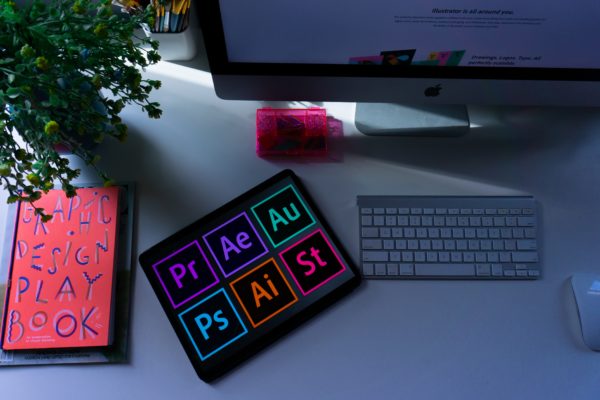
As a marketing professional in the healthcare field, you know all too well that the messages we communicate to our audiences are naturally complex. Physical and mental health topics can be intimidating and scary to patients. The language of the practitioners we work with is dense. And those complexities may create barriers to people who need to access care.
Our work is to inform, inspire, and persuade. And sometimes, words aren’t enough.

Graphic design can help our audiences process and act on complex information. And ultimately, our messages aim to educate. You’re probably familiar with the three types of learning styles by which people take in and process information: visual (via images and graphics), auditory (via spoken word), and kinesthetic (via touch or physical engagement). Research suggests that about 65% of the population are visual learners. And multiple modes of communication engage different parts of the brain, which enhances comprehension and retention.
In short, text plus visuals make healthcare marketing more effective. So let’s look at the elements of graphic design your team can leverage:
Layout and hierarchy of messaging — In a print brochure or a website, the arrangement of copy on the page can enable a reader’s understanding or totally derail it. Use typography for headlines and subheads to highlight essential information, and design elements like bullet points to arrange the copy into easily digestible chunks. Layout can also effectively guide the reader’s eye through the information in a logical path.

Infographics – Visual representations of information and data (icons, charts, or more detailed graphics) are extremely effective at simplifying the complex. They help your audience process facts quickly. Infographic design is a specialized discipline that takes a skilled right-brain-left-brain artist.
Photography and illustration — These graphic elements are essential especially in a storytelling capacity, where you aim to communicate the human results of your organization’s work. When you’re showcasing the people your senior services nonprofit helps, or the patients who benefit from your healthcare network’s surgery centers, use photos or illustrations to put faces on outcomes. Photography also supports your efforts to persuade your audience to take steps toward a healthier lifestyle — by showing that real people who look like them do these things. Be sure that your visual library accurately represents the community you serve.
Video — Because video has become so easy to capture with mobile devices, this medium is a growing asset in the healthcare marketer’s visual toolkit. There may be no better way to demonstrate a task or service than by walking your audience through it step by step. Video interviews are a great way to humanize your practitioners and to share patient success stories.
All of these elements work together with content to communicate, whether you’re planning a short-term social media campaign or a multichannel brand identity initiative.
When a large academic healthcare network recently faced public and political pushback — that it was too big, too unwieldy, and too unresponsive — their marketing team came to us for guidance. Our challenge was to communicate that the network’s size is its strength, that its reach across the region offered multiple options for care, and that patients ultimately benefit from its broad array of specialties and services.
Facing a timeline dictated by legislative meetings, we had to work quickly to clarify this complex network in a way that persuaded and reassured.
As the leadership team worked to clarify their strategic position on these issues, we got to work on a plan to develop a secondary website for the awareness campaign. We created a sub-brand that carried the organization’s look and feel in a fresh way.
We were presented with reams of internal documents and set about compiling and rewriting the content so it would be more understandable. Even though this was an external communication project, the target audience wasn’t typical — we needed to persuade legislators, local officials, and media, not the usual community of patients.
In order to distill a complex subject into a key message — that the network’s size and scope make it a valuable regional asset — we developed a library of infographics that show how all the elements of the organization work together, why a large integrated system benefits patients, how it all works together to better serve patients, and how its employment base contributes to the area.
Creating compelling infographics is as much a strategic project as a creative one, with an intensive research process and lots of technical expertise required. In spite of the tight project timeline, we made sure our visual designers had the time and resources needed to do the work right.
These graphics played a featured role on the initiative’s website and in downloadable information sheets that show quickly and compellingly how the system works and why it matters.
As healthcare marketing increasingly follows the path of consumer marketing, where brands build relationships with their consumers, graphic design will become even more important. And design isn’t just about adding pretty pictures or icons. With the proper consideration behind it, it’s a powerful communication strategy.
If your team could use strategic visual communication support, we can help. Let’s begin the conversation.
Tenth Crow Creative is a brand marketing agency that creates, aligns, and promotes messaging for health and wellness organizations. Through insightful branding, engaging design and compelling marketing campaigns, we help these essential organizations find their identities and effectively communicate with their stakeholders so they can fulfill their missions.
Posted By
Tenth Crow Creative
Categories
Branding, Content Marketing, Design, General, Healthcare Marketing, Marketing
Tags
#healthcarebranding, #healthcaremarketing, #nonprofitmarketing